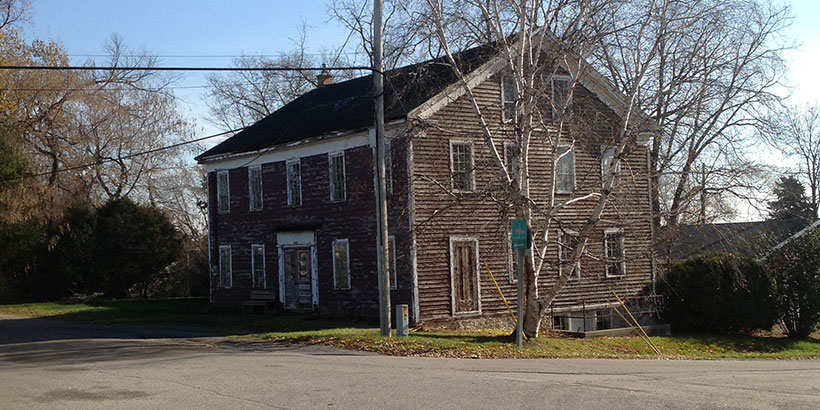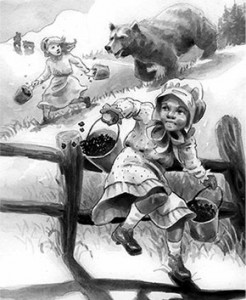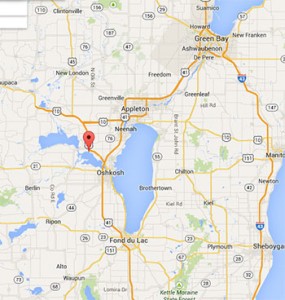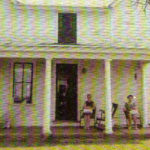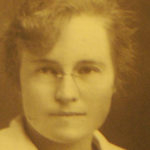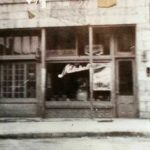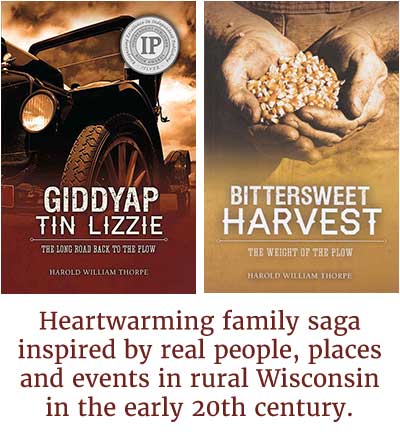In Aubrey’s Attic, two young girls find adventure, and meet new animal friends, in the attic of a 170-year-old, former hotel in Butte des Morts, Wisconsin. In the attic, they rehearse for an upcoming local history production about Sophia Grignon, whose father, fur trader Augustin Grignon, built the three-story structure in the 1840s.
The Greek Revival-style Grignon Hotel, which still stands on Main Street in Butte des Morts, has at various times been operated not just a hotel, but also as a fur trading post, general store, post office, tavern, and antique store. It was added to the National Register of Historic Places in 1975.
Once owned by the Winnebago County Historical and Archaelogical Society, the property is now in private hands. Local groups, including the Butte des Morts Lions Club, have expressed interest in restoring it. The Winnebago County Historical and Archaeological Society plans to erect a historical marker at the site in 2014. A recently formed Butte des Morts Historical Preservation Society, that will hold its inaugural meeting June 22, 2014, will also likely discuss whether to involve itself in the building’s restoration.
The annual Butte des Morts founders pageant in Aubrey’s Attic, is a fictional event. So, too, did I make up the story of Sophia and her friend, Sadie, being chased by a bear while berry picking. Aaron Boyd’s illustration of Sophia is imagined; no historical portraits exist of her.
And the Grignon Hotel’s Underground Railroad connection, which I write about in Aubrey’s Attic, is based on unconfirmed local lore. There is no definitive evidence that this was an Underground Railroad stop, where runaway slaves were secreted en route to freedom in Canada. Those stops were purposely shielded from discovery through careful lack of written documentation. We’ll likely never know the full truth.
Such are the liberties I’ve taken as a historical fiction writer.
However, the Butte des Morts Lion’s Club does sponsor Carp Fest every summer.
And I incorporated into Aubrey’s Attic true-life elements of the Grignon Hotel
When I sat down to write Aubrey’s Attic, I liked that the hotel had an attic. An attic was a great place for the story’s two young girls to dig up some history, and it provided an opportunity for some catchy alliteration in the title; an ‘a’ word to match the name of my granddaughter, Aubrey.
And, of course, the Grignons were a real-life family, who made significant contributions to early Wisconsin history.
When did the Grignons arrive in Wisconsin? What did they contribute to state — and Butte des Morts — history?
And what, ultimately, became of Sophia?
Here’s their story.
The Grignons were among a small number of well-off, elite families of Metis descent – mixed French Canadian and American Indian blood – who rose to prominence in Wisconsin in the late 18th and early 19th Centuries. Lucy Eldersveld Murphy, in her excellent 2000 book A Gathering of Rivers: Indians, Metis and Mining in the Western Great Lakes, 1737-1832 (University of Nebraska Press, $29.95), discusses their status as the region’s “elites” of the day.
“As these communities matured and their social hierarchies emerged, a handful of families came to dominate Green Bay and Prairie du Chien. In the latter town these included the Brisbois, Fishers, and Rolettes, while in Green Bay it was the Grignons – descendents of the Langlades – and the Franks/Lawe families that dominated.”
Augustin Grignon, born in 1780 in Green Bay, was one of twelve children of French Canadian fur trader Pierre Grignon. By the time Augustin was born, his family had been in Green Bay for many years.
Pierre Grignon had arrived at Green Bay around 1760. And Augustin’s maternal grandfather, Charles de Langlade, had established a fur trading post in Green Bay in 1745. Charles de Langlade is commonly believed to have been the first permanent white settler in Wisconsin and has been called the “Father of Wisconsin.” Langlade County, in northern Wisconsin, is named after him. Charles de Langlade went on to play a prominent warrior role in the French and Indian War, which lasted from 1754-1763.
In 1805, Augustin married Nancy McCrea, the Metisse daughter of a Canadian fur trader and a Menominee Indian woman. They settled about 25 miles southwest of Green Bay, on the Fox River at what today is Kaukauna. Augustin and Nancy Grignon went on to have six children — Margaret, Charles, Alexander, Paul, Louis, and Sophia.
Sophia was born around 1815. In 1818, when she was about three years old, her father established a trading post at present-date Butte des Morts, about 40 miles southwest of Kaukauna. Around this time, Augustin also made a big decision: in 1820, he relinquished his allegiance to the British Empire that ruled Canada, and became a US citizen.
The family remained living in Kaukuana, however, and Augustin continued to operate a trading post there, too. Then, in 1840, Augustin purchased the land at Butte des Morts on which the Grignon Hotel still sits. Then, Augustin and a large contingent of his extended family relocated permanently to Butte des Morts. The 1840 federal census lists about two dozen Grignon family members as living in Winnebago County, ranging in age from less than five to seventy years old. It was the first census in which the Grignons were listed as living in Winnebago County. The Grignon Hotel is believed to have been built soon afterward.
Sophia’s brothers, meanwhile, took over the Kaukauna trading post operation.
In 1837, Sophia’s brother, Charles, who worked as an Indian agent, built an elegant Greek Revival mansion at Kaukauna for his new wife. It had five fireplaces and eleven bedrooms. Restored in 1941, and added to the National Register of Historic Places in 1972, the Grignon Mansion is now a museum.
Augustin Grignon remained busy in Winnebago County.
In 1848, he platted the village of Butte des Morts. The town of Winneconne was created at meeting at his house on April 14, 1848. Beginning in 1849, he served as the local post master. And throughout the 1840s and early 1850s, he fought unsuccessfully to have Butte des Morts named the Winnebago County seat; it ultimately lost out to Oshkosh.
Augustin Grignon died in 1860, at the age of 79. See a photo of Augustin Gringnon later in life, from the Wisconsin Historical Society’s Visual Materials Collection.
The Grignon family owned the hotel at Butte des Morts until 1866, when it was auctioned off in a sheriff’s sale. The property has since changed hands many times. Originally, it overlooked a wide marsh that extended to the Fox River. In 1856, the lower Fox River was dammed, and the water rose to create Big Lake Butte des Morts. Today, the hotel building sits about a block from the lake.
Today, Butte des Morts is a small, unincorporated village of about 1,000 residents in the town of Winneconne, in Winnebago County.
And what happened to Augustin’s daughter, Sophia?
In 1841, Sophia married Louis Porlier. Louis was Augustin Grignon’s business manager and, like his wife, had longtime, elite family ties in Green Bay. Louis was born in 1814 in Green Bay.
Louis’ father, Jacques Porlier, had come to Green Bay from Montreal, Canada in 1791 and had worked for a time as the Grignon family’s live-in tutor, educating Augustin Grignon and his siblings. Jacques Porlier is commonly believed to have been the first white schoolteacher in Green Bay. Later, he worked as a fur trader and a business partner to Augustin Grignon in Butte des Morts. In the 1820s he was named Chief Justice of Brown County. Jacques Porlier died in 1839.
Sophia and Louis had two sons. Charles was born in 1842, Augustine in 1845. In the 1860s, Charles fought in the Civil War. Sadly, Sophia didn’t live to see her sons grow up. She died in 1845. It’s not clear whether she died in childbirth, or of some other cause soon after Augustine’s birth. One account has her living on the family’s property in Kaukauna prior to her death.
The large, extended Grignon family went on to record other accomplishments in Wisconsin, into the 20th Century.
One last footnote on the Grignons…
and this one is a bit macabre.
Augustin Grignon, seven other members of his family including Sophia, and two family friends, were buried in unmarked graves on their property in Butte des Morts. The location of their graves remained unknown until the 1930s, when the curator of the Grignon Mansion in Kaukauna found mention of them in old family letters. In 1941, the remains of all ten were exhumed, with the intention of their being reburied in Kaukauna. That didn’t happen immediately, however. For the next 20 years, their bones were held in storage by a local undertaker. Finally, in 1961, they were permanently laid to rest in Kaukauna’s Holy Cross Cemetery.
The Good Friends Storybooks are chapter books for middle school children that mix adventure, quirky talking animals, gentle lessons about friendship, and Wisconsin history. Aubrey’s Attic is available through Amazon, and many local bookstores. You can also download a sample chapter today.

